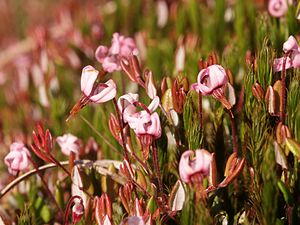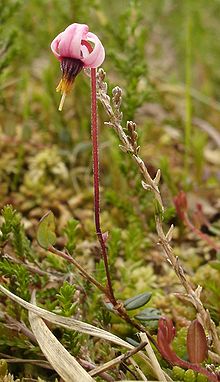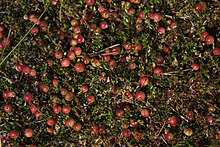Common cranberry
| Common cranberry | ||||||||||||
|---|---|---|---|---|---|---|---|---|---|---|---|---|

Common cranberry ( Vaccinium oxycoccos ) |
||||||||||||
| Systematics | ||||||||||||
|
||||||||||||
| Scientific name | ||||||||||||
| Vaccinium oxycoccos | ||||||||||||
| L. |
The common cranberry ( Vaccinium oxycoccos , syn. Oxycoccus palustris Pers. ) Is a representative of the blueberries ( Vaccinium ) within the heather family (Ericaceae). Characteristic of this dwarf shrub are its "trunks", reduced to thin threads, with which it twines flatly over peat moss.
Surname
The scientific name Oxycoccus (written oxycoccos in the second part of species names) is derived from the Greek oxys = sour / spicy and kokkos = berry. This refers to the sour-tasting berries.
description
The common cranberry is an evergreen, thread-like, prostrate, dwarf shrub (woody Chamaephyte ), the stems of which can crawl up to a meter. It becomes about two to six centimeters high. The leaves are leathery, elliptical to lanceolate with the greatest width at the base. They are dark green on top, whitish green on the underside, with entire margins and with the edge rolled up towards the tip and bare. They are five to ten millimeters long.
The pink, terminal flowers sit in groups of one to four on pedicels up to five centimeters long. This has two red bracts, one to two and a half millimeters long. The crown of the flowers is five to seven millimeters long and has four to five turned back tips. The fruits reach up to eighteen millimeters in diameter. Depending on the shape of the fruit, different shapes are sometimes distinguished. The fruits are yellow-red to red, partly speckled. The plant blooms from May to August. The fruits ripen from August.
The number of chromosomes is 2n = 48.
Location and distribution
The cranberry grows preferentially on bog soils . The cranberry is circumpolar, up to about 71 ° north latitude. It is common in Scandinavia, the Baltic States , Northern Russia , Japan and North America . In the Alps it grows up to a height of 1500 meters. In the Allgäu Alps it rises to an altitude of 1400 meters.
It is a characteristic plant of the Bulte in Bult-Schlenken complexes of rain bogs , but also occurs in intermediate bogs and swamp forests . It is a Sphagnetalia order character, but also occurs in societies of the Rhynchosporion association.
ecology

The common cranberry is an evergreen, thread-like, prostrate, dwarf shrub (woody Chamaephyte ), the stems of which can crawl up to a meter.
The flowers are "bluebells with a scatter cone", which in this case is completely open. The flowers of the cranberry are pollinated by insects , especially bees and bumblebees ( entomogamy ). The lifespan of the flowers is around 18 days, making it one of the longest in the local flora. Flowering time is from May to August.
The fruits are berries that last until the next summer. After the frost they become soft and are spread after consumption and excretion of the seeds by animals , especially birds ( endochory ). Fruit ripening is from August. The plant is a winter stand . Often the fruits only reappear after the snow has melted and can only then be spread. The seeds are light germs .
Vegetative propagation occurs through rooted, leafy creeping shoots.
The plant is a semi-light plant, that is, it grows in full light, but tolerates shade to a limited extent. Their ecological focus is on wet and extremely low-nitrogen, mostly acidic to moderately acidic soils.
The construction of the plant as an adaptation to water availability and gas metabolism reflects its site conditions. The cranberry is scleromorphic . The leathery, about twelve millimeters long leaves are hard due to the strengthening tissue. The underside of the leaf is waxy and protects the leaves from water loss in winter.
While most animals disdain the hard leathery leaves of the common cranberry, the caterpillar of the cranberry moth ( Carsia sororiata ) and probably also the high-moor mother-of-pearl butterfly ( Boloria aquilonaris ) feed exclusively on this plant. A third species, which also eats related heather plants ( Ericaceae ), is the blue moorland ( Plebejus optilete ).
Hazard and protection
The common cranberry is not protected by law anywhere in the world. In Germany, however, it is considered to be endangered (hazard category 3). The population development is given as constant, that is, its decline coincides with its increase. The species is native to the Federal Republic of Germany (indigenous). Your area share here is between ten and 33 percent.
ingredients
The cranberry is edible. The berries are rich in vitamin C (15–30 mg / 100 g), minerals (0.2–0.3%), pectin (0.4–0.8%), organic acids (especially citric acid , benzoic acid and Chlorogenic acid ) and sugar (2.4-6.1%). Their locations are predominantly in nature reserves . Therefore, collecting the fruits is only possible in exceptional cases. Their red berries have a slightly bitter taste that is somewhat similar to that of the cranberries. Cranberries are mostly used for roast wild boar, venison or roe deer. Cranberries are processed into jam , dried fruit, tea and juice. The fruits are also used in baked goods, liqueurs, vitamin preparations and creams. Regionally they are served with pancakes and quark dishes. For cranberries, local berry pickers in the Baltic EU member states are paid by far the highest prices for wild berries. The fruits are ripe and harvested from September to October.
Sources and further information
literature
- M. Natkevičaitė-Ivanauskienė: Lietuvos TSR flora vol. V. Vilnius 1976.
- Ruprecht Düll , Herfried Kutzelnigg : Pocket dictionary of plants in Germany and neighboring countries. The most common Central European species in portrait. 7th, corrected and enlarged edition. Quelle & Meyer, Wiebelsheim 2011, ISBN 978-3-494-01424-1 .
Individual evidence
- ↑ Henning Haeupler , Thomas Muer: picture atlas of the fern and flowering plants of Germany (= The fern and flowering plants of Germany. Volume 2). Published by the Federal Agency for Nature Conservation. Ulmer, Stuttgart 2000, ISBN 3-8001-3364-4 .
- ↑ a b Erich Oberdorfer : Plant-sociological excursion flora for Germany and neighboring areas . With the collaboration of Angelika Schwabe and Theo Müller. 8th, heavily revised and expanded edition. Eugen Ulmer, Stuttgart (Hohenheim) 2001, ISBN 3-8001-3131-5 , pp. 733 .
- ↑ Erhard Dörr, Wolfgang Lippert : Flora of the Allgäu and its surroundings. Volume 2, IHW, Eching 2004, ISBN 3-930167-61-1 , p. 306.
- ↑ Heinz Ellenberg, HE Weber, R. Düll, V. Wirth, W. Werner, D. Paulißen: Pointer values of plants in Central Europe. Scripta Geobotanica 18, Verlag Erich Goltze, 1992, ISBN 3-88452-518-2
Web links
- Vaccinium oxycoccos L., Common cranberry. In: FloraWeb.de.
- Common cranberry . In: BiolFlor, the database of biological-ecological characteristics of the flora of Germany.
- Vaccinium oxycoccos L. In: Info Flora , the national data and information center for Swiss flora . Retrieved January 14, 2016.
- Map of the worldwide distribution of the common cranberry
- Thomas Meyer: Cranberry data sheet with identification key and photos at Flora-de: Flora von Deutschland (old name of the website: Flowers in Swabia )




